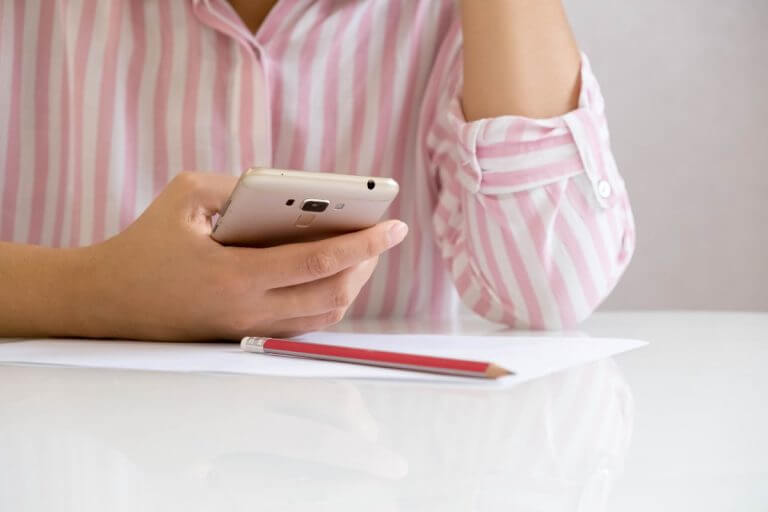This website uses cookies so that we can provide you with the best user experience possible. Cookie information is stored in your browser and performs functions such as recognising you when you return to our website and helping our team to understand which sections of the website you find most interesting and useful.

Students tap away on laptops, a phone buzzes, then another, and another. Every face is lit up in the light from a screen. A lecture hall full of students yet only one or two write in notebooks. The rest glare at screens.
It is a familiar sight and one many educators are desperate to change. But with social media, tech disruptions and the rise of edtech comes this unnerving truth: students are getting hooked on electronics.
Even investors in arguably the largest tech company in the world have entered the dialogue. Two large investors in Apple recently called for action over young people’s worrying addiction to smartphones.
And with studies showing excessive smartphone and social media usage is linked to poor mental health, concerns are growing.
"The classroom is a place where ideas need to be explored and expanded upon, where stories and anecdotes need room to develop, and where information is brought alive in ways an online substitute cannot achieve." https://t.co/TyFdBrcmQ6 by @alannaharv @DrBrynnWinegard pic.twitter.com/ktX4ziYrVe
— Flipd (@Flipd_app) January 29, 2018
In response, many educators are rethinking technology’s role in the classroom. While they want to prepare children for the digital world, they also do not want them to become reliant on their devices for learning.
France recently banned smartphones from their classrooms altogether, but many educators in other countries are keen to find a middle-ground.
This was the motivation behind Flipd, an app that can be used both inside (and outside) the classroom to self-regulate students’ phone use. The app has been growing in popularity since its launch in 2016, its user base expanding from 2,000 regular student users to over 15,000 with nearly 200,000 downloads worldwide.
Flipd switches off a student’s phone for anything other than emergency calls. They can “Flip” back on at any point during a lecture, but it logs how long they were “Flipd” off for.
"Phones and apps aren't good or bad by themselves, but for adolescents who don't yet have the emotional tools to navigate life's complications and confusions, they can exacerbate the difficulties of growing up." @melindagateshttps://t.co/wiogIjQJ4I by @cnn @MikeNedelman
— Flipd (@Flipd_app) January 22, 2018
Based in Toronto, Flipd now operates in a number of colleges all over the US and Canada and, as of this semester, in the UK.
“There are often two extremes,” Flipd co-founder Alanna Harvey told Study International. “On the one hand ‘let’s embrace technology. Let’s pump as much technology into classrooms as we can.’ Or, let’s go down France’s route and just ban tech altogether.”
Flipd is trying to “reinforce” a balance to the polarising debate, she said.
"While our phones serve as alarm clocks, music players, and sources of endless scrolling, it's been found that stepping away to unplug for short periods of time can lead to more fulfilling, productive and healthier lives." https://t.co/q9tyNbcIwd by @melissalexdoyle pic.twitter.com/VT01oBcitN
— Flipd (@Flipd_app) January 26, 2018
The app costs US$4 per semester. Harvey and her team have found the cost is low enough that it is affordable to students but high enough it makes them think about using it. Students are encouraged, but not forced, to use the app. It creates a form of ownership.
And it’s working. In classrooms where Flipd is used, 90 to 95 percent of students voluntarily downloaded the app.
Finding a tech-life balance
“We worked with professors at a few different universities in North America and we found that this [distraction from tech in the classroom] is a pretty profound and growing issue in K-12 and higher ed,” Harvey told Study International.
Educators are the forefront of what Flipd is doing. Many are big advocates of the notion of single-tasking in the classroom.
“The professors are the ones researching this issue. There are so many studies out there and more recently they have come to light and have been published,” Harvey said.
One of these professors is Dr Lorenz S. Neuwirth, an Assistant Professor of Biopsychology at The State University of New York College at Old Westbury. He has used Flipd for two years across six different courses in Psychology with over 300 students.
How should teachers — both K-12 and college — deal with the use of computers and phones by students in class? https://t.co/OcoJvHS3AY
— NPR (@NPR) January 24, 2018
Neuwirth claimed that as we “move towards a more digital frontier there are as many benefits as there are risks.”
Keeping students interested enough to stay off their phones is a challenge
Neuwirth told Study International, “faculty are continually challenged with grasping and sustaining student attention within the classroom while competing with other information that students may be more inclined, motivated, or interested in beyond the curriculum,” notably their mobile phones.
Assistant Teaching Professor of Psychology at Pennsylvania State University Dr. Alicia Drais-Parrillo PhD who began using Flipd in the fall of 2016 agrees: “I think, students, over the last few years, have become more distracted and people, in general, struggle with delay of gratification.”
Student breaks phone, has a revelation: "I’m starting to see the world a lot differently without my phone. I'm actually focusing on school a lot more. I'm actually engaging with my classmates, talking to people around me." @azfamily https://t.co/ikjVSX2hhO
— Alanna Harvey (@alannaharv) January 11, 2018
Disconnecting from technology allows students to “begin to re-experience what the curriculum can offer when they have perhaps a less divided attention,” Neuwirth said.
Staying off your phone could boost your grade
Neuwirth makes Flipd worth five percent of his students’ grades and adds another five percent for physical attendance to ensure students do not just stay in their dorms with the app on.
So if students don’t attend his classes, or if they do and they are not engaged, they cannot earn a high mark.
Dr Drais-Parrillo uses a similar method to Neuwirth. She receives data on how long students were “Flipd” off for during her lectures. This is then translated into a point system and used as an incentive to boost students’ grades.
She claimed this encouraged even more students to use Flipd.
" @Flipd_App helps the professors better understand at what point are students getting bored, checking Instagram or deciding to check out of the lecture for whatever they want to do. "https://t.co/qbtBkk6oGF by @cbc pic.twitter.com/akxDixvNw8
— Flipd (@Flipd_app) January 21, 2018
Her points system is put into a leaderboard, and she even places herself in the competition. She tells her students whoever beats her will get an extra bonus. This applies to time outside of class as well.
“So I am essentially reinforcing them for not using their phones outside of class [too],” she said.
Neuwirth claimed “after one week of students using Flipd, which is only two classroom exposures, students adapt and make positive changes to their behaviours. They take notes in class and become more active in taking responsibility for their own education.”
However, he said students do get “active learning fatigue.”
They found it increasingly difficult to handwrite notes. “It was like I asked them to ride a bike and they hadn’t done so in a decade. They actually had to re-learn the motor memory to take notes.”
Many educators don’t want to totally ban tech
But this doesn’t mean the educators want technology cut out altogether.
Neuwirth claimed he uses other technology in the classroom such as Kahoot, an interactive gaming app for the classroom.
Challenge your Ss with Kahoot! at 🏠! Check 👉 https://t.co/O3VZxF1WoG on how to make homework kahoots in the mobile app!📚
— Kahoot! (@Kahoot) January 31, 2018
“In the last 15 minutes of my classes, I display a pop quiz with Kahoot and monitor my students’ learning comprehension through their percent of correct responses,” he said.
“This behaviour habit reversal of restricting cellular phone access to limited learning time periods with reinforcement, as well as their successful completions of tests and exams, naturally reinforce students to continue taking notes, reduce their cellular phone habits and become more active learners within the classroom.”
Drais-Parrillo takes a similar approach. She claimed she uses other tech in the classroom to keep students engaged, but limits it to the necessary.
She doesn’t want to ban devices, but instead “shape good behaviour and encourage students to make good choices, not simply force them into it.”
“No one is engaged in learning, just social media. Technology is supposed to be an educational tool not a hindrance.” https://t.co/4NsLDPuZwF by @HuffPostBlog @alannaharv
— Flipd (@Flipd_app) January 22, 2018
However, she stated she is always careful about when, how and why she uses technology in her lessons.
“We should demonstrate meaningful use of technology for our students and perhaps the lesson will be absorbed,” she said.
Dr Drais-Parrillo told Study International:
“Parents and educators need to be aware and should be working with younger generations on delay of gratification, self-control, and seeing devices as tools, not extensions of themselves.
“We are in a position to put students on the right path; it’s up to them to stay on the path, but I try to do everything I can to help them along the way.”
Liked this? Then you’ll love…
Students beware: Your smartphone could be damaging your education
Hindrance or help? Free cellphones granted to US high school students








